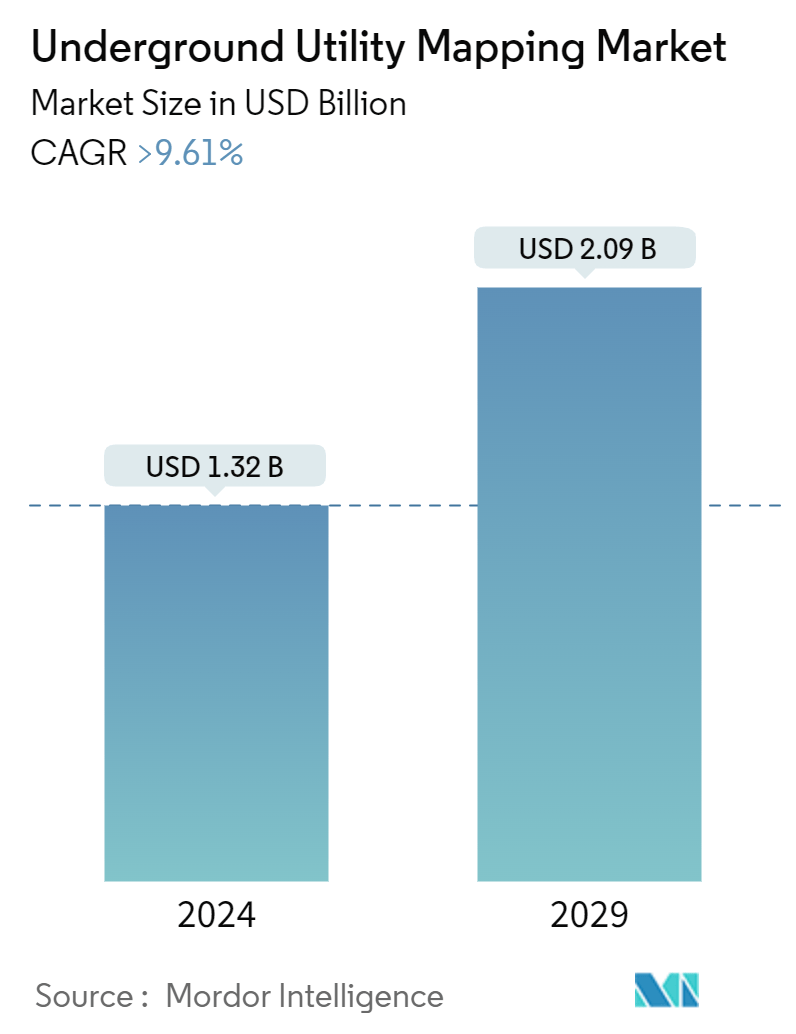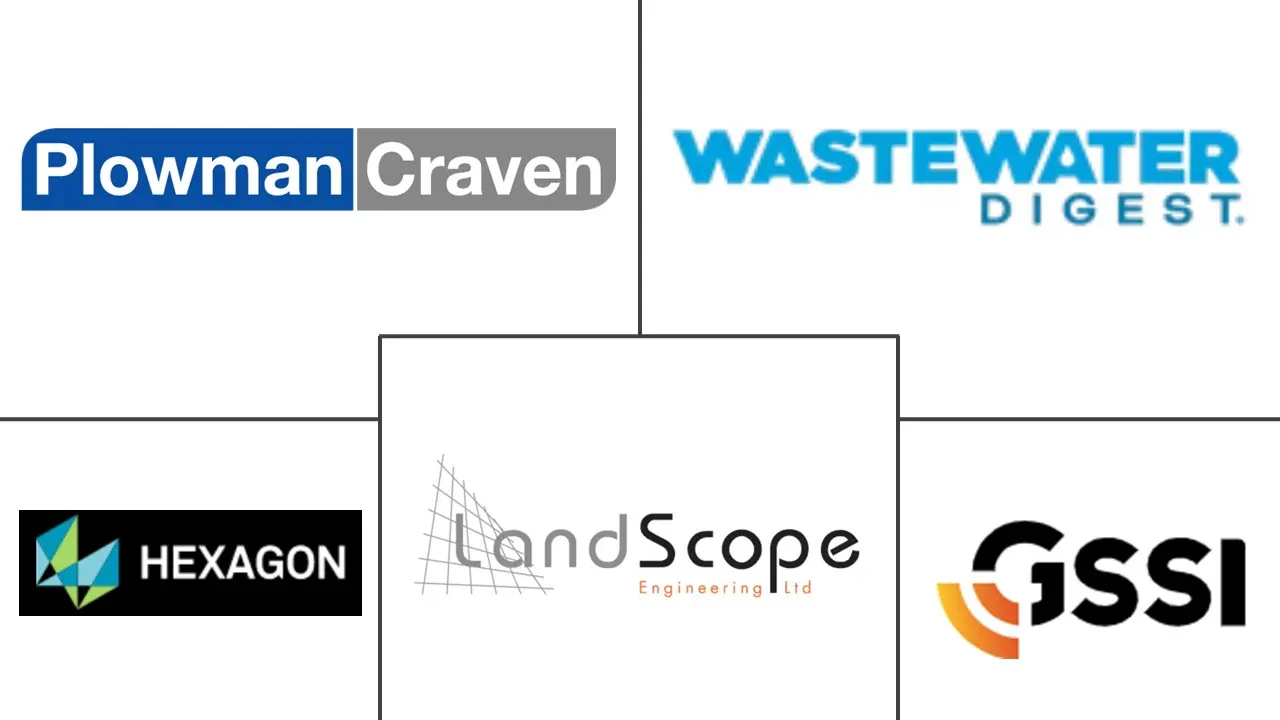Market Size of Underground Utility Mapping Industry

| Study Period | 2019 - 2029 |
| Market Size (2024) | USD 1.32 Billion |
| Market Size (2029) | USD 2.09 Billion |
| CAGR (2024 - 2029) | 9.61 % |
| Fastest Growing Market | Asia Pacific |
| Largest Market | North America |
| Market Concentration | Medium |
Major Players
*Disclaimer: Major Players sorted in no particular order |
Underground Utility Mapping Market Analysis
The Underground Utility Mapping Market size is estimated at USD 1.32 billion in 2024, and is expected to reach USD 2.09 billion by 2029, growing at a CAGR of greater than 9.61% during the forecast period (2024-2029).
Two primary factors are propelling the underground utility mapping market: heightened economic activities, especially in developing nations, and increasing government initiatives aimed at maintaining these underground utilities.
- In recent years, the subsurface utility engineering (SUE) industry has been at the forefront, crafting innovative solutions to the challenges of mapping underground utility infrastructures. By melding geophysical technologies, such as electromagnetic locators and ground-penetrating radars, with non-technical methods like historical records, the industry is able to amass a comprehensive dataset of subsurface infrastructures.
- Moreover, the World Economic Forum anticipates that global investments in urban grey infrastructure will skyrocket to USD 10,548 billion by 2030. Such monumental urban development investments herald a significant growth opportunity for the underground utility mapping market.
- As urbanization accelerates, the global trend of smart cities is gaining traction. The United Nations projects that by 2050, urban populations will swell by 404 million in India, 292 million in China, and 212 million in Nigeria.
- Meanwhile, Latin America, an emerging continent, is experiencing the swiftest urbanization. With numerous global smart city projects in motion, international investments are pouring in. The Organization for Economic Cooperation and Development (OECD) estimates that from 2010 to 2030, global investments in smart city initiatives will near USD 1.8 trillion, encompassing all metropolitan infrastructure projects. This surge in smart city developments is set to amplify demand in the underground utility mapping market.
- Infrastructure planning, often sidelined in urban development, is vital for the seamless operation of complex facilities. A pivotal tool in this endeavor is 3D utility mapping, which provides a three-dimensional perspective of an area and its utilities. This method captures subsurface data, encompassing water, sewer, and gas lines, alongside structural maps and electrical wiring. Armed with a detailed 3D utility map and a Conceptual Site Model (CSM), planners can swiftly pinpoint challenges and devise effective solutions.
- By merging emerging technologies with utility maps, the underground utility mapping market is undergoing a transformation. These advancements bolster the accuracy, efficiency, and safety of exploration activities. Consequently, exploration teams can adeptly navigate challenges tied to underground infrastructure, streamline their routes, and mitigate risks, driving the market's growth and fostering innovation.
- While Ground Penetrating Radar (GPR) excels at pinpointing the horizontal locations of targets, various factors can sway the speed and precision of depth measurements. Soil type and moisture content are pivotal. For instance, radar signals slow down in challenging soils like sand and clay. Moisture-rich materials further influence signal speed. Thus, while pinpointing the exact speed of GPR signals across different materials poses challenges, estimates generally hover around 90% accuracy.
Underground Utility Mapping Industry Segmentation
Accurate information on existing underground utilities is required to plan and install new utilities and excavate existing utilities. The subsurface utility mapping market scope tracks the adoption of various solutions and services used by multiple end-use industries such as electricity, public safety, building and construction, oil and gas, telecommunication, etc. The report also focuses on the effects of the pandemic on the ecology of the utility mapping market. The scope includes the existing vendor landscape for significant market players.
The underground utility mapping market is segmented by component type (solutions and services), by end-user industry (public safety, oil and gas, building and construction, telecommunication, electricity, and other end-user industries), and by geography (North America, Europe, Asia Pacific, Latin America, and Middle East and Africa). The market sizes and forecasts are provided in terms of value (USD) for all the above segments.
| By Component Type | |||||
| |||||
| Services |
| By End-user Industry | |
| Public Safety | |
| Oil and Gas | |
| Building and Construction | |
| Telecommunication | |
| Electricity | |
| Other End-user Industries |
| By Geography*** | |
| North America | |
| Europe | |
| Asia | |
| Australia and New Zealand | |
| Latin America | |
| Middle East and Africa |
Underground Utility Mapping Market Size Summary
The underground utility mapping market is experiencing significant growth, driven by the increasing need for accurate and efficient mapping solutions in civil engineering and infrastructure development. This market is essential for preventing costly repairs and project delays caused by accidental utility strikes. The industry has seen advancements in subsurface utility engineering, utilizing geophysical technologies like electromagnetic locators and ground-penetrating radars, alongside historical records, to enhance mapping accuracy. The integration of emerging technologies, such as app-based solutions and GPR-enabled drones, is revolutionizing the market by improving the precision, efficiency, and safety of utility mapping activities. These innovations are particularly crucial in densely populated urban areas, where the complexity of underground infrastructure demands precise mapping to avoid disruptions during construction.
The market is characterized by a semi-consolidated structure, with both global players and small to medium-sized enterprises competing for market share. Key players are engaging in strategic partnerships and acquisitions to enhance their offerings and maintain a competitive edge. The COVID-19 pandemic has accelerated the adoption of digital technologies in the sector, highlighting the importance of digitizing and automating processes. North America, in particular, is witnessing a surge in demand for underground utility mapping services due to rapid urbanization and smart city initiatives. The region is also focusing on data sharing methods to improve infrastructure management. As the market continues to expand, the combination of advanced technologies and strategic collaborations is expected to drive further growth and innovation in underground utility mapping solutions.
Underground Utility Mapping Market Size - Table of Contents
-
1. MARKET INSIGHTS
-
1.1 Market Overview
-
1.2 Industry Attractiveness - Porter's Five Forces Analysis
-
1.2.1 Threat of New Entrants
-
1.2.2 Bargaining Power of Buyers/Consumers
-
1.2.3 Bargaining Power of Suppliers
-
1.2.4 Threat of Substitute Products
-
1.2.5 Intensity of Competitive Rivalry
-
-
-
2. MARKET SEGMENTATION
-
2.1 By Component Type
-
2.1.1 Solutions
-
2.1.1.1 Ground Penetrating Radar
-
2.1.1.2 Electromagnetic Locators
-
2.1.1.3 Other Solutions
-
-
2.1.2 Services
-
-
2.2 By End-user Industry
-
2.2.1 Public Safety
-
2.2.2 Oil and Gas
-
2.2.3 Building and Construction
-
2.2.4 Telecommunication
-
2.2.5 Electricity
-
2.2.6 Other End-user Industries
-
-
2.3 By Geography***
-
2.3.1 North America
-
2.3.2 Europe
-
2.3.3 Asia
-
2.3.4 Australia and New Zealand
-
2.3.5 Latin America
-
2.3.6 Middle East and Africa
-
-
Underground Utility Mapping Market Size FAQs
How big is the Underground Utility Mapping Market?
The Underground Utility Mapping Market size is expected to reach USD 1.45 billion in 2025 and grow at a CAGR of greater than 9.61% to reach USD 2.29 billion by 2030.
What is the current Underground Utility Mapping Market size?
In 2025, the Underground Utility Mapping Market size is expected to reach USD 1.45 billion.

